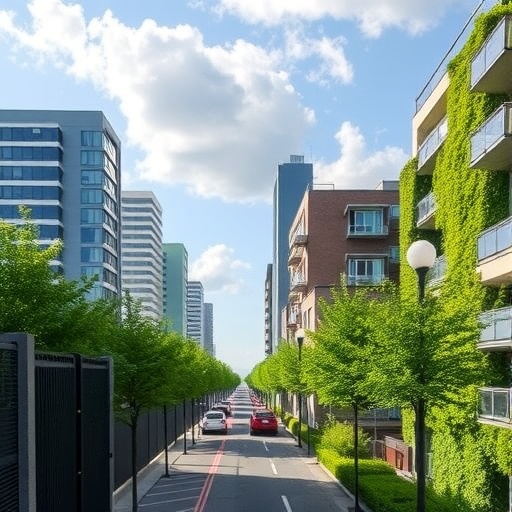
In an era where urban heat islands increasingly threaten the livability of cities worldwide, a groundbreaking study published in npj Urban Sustainability offers a transformative perspective on how green spaces can serve as adaptive cooling mechanisms in complex urban environments. Researchers Wang, Zhou, and McPhearson present a novel theoretical framework that leverages a general power law function to identify optimal size thresholds for green spaces, redefining the strategic design and implementation of urban greenery to mitigate rising temperatures effectively.
Urban areas are notorious for creating microclimates markedly hotter than surrounding rural zones, a phenomenon termed the urban heat island effect. This occurs primarily because buildings, roads, and other infrastructural elements absorb and retain heat, leading to elevated temperatures that exacerbate climate stressors, energy consumption, and human health risks. Green spaces, including parks, street trees, and urban forests, have long been hailed as natural mitigators capable of reducing local temperatures through shading, evapotranspiration, and altering wind patterns. However, the challenge lies in identifying how large these green spaces must be to provide maximum cooling benefits without compromising urban land use efficiency.
The crux of the study lies in applying a general power law function—a mathematical model characterized by the relationship y = ax^b, where ‘a’ and ‘b’ are parameters defining the scaling relation—to quantify how cooling effects scale with the size of green spaces. This analytical approach provides a universal scaling rule that transcends city-specific idiosyncrasies, offering a robust predictive tool to optimize green space configuration for climate adaptation strategies. By systematically synthesizing temperature data from diverse urban settings, the authors establish a size threshold below which green spaces’ cooling utility diminishes significantly, and above which gains plateau or scale sub-linearly.
.adsslot_HpLcYl2wPb{width:728px !important;height:90px !important;}
@media(max-width:1199px){ .adsslot_HpLcYl2wPb{width:468px !important;height:60px !important;}
}
@media(max-width:767px){ .adsslot_HpLcYl2wPb{width:320px !important;height:50px !important;}
}
ADVERTISEMENT
This revelation is particularly pivotal for urban planners and policymakers tasked with balancing competing demands for land in densely populated cities. The research suggests that incremental expansions of green spaces below the threshold yield disproportionately small cooling benefits, whereas surpassing the threshold enables green spaces to function as effective climatic buffers, reducing ambient air temperatures and mitigating peak heat events. Such optimized scalability implies that not all green spaces are created equal in their ecological service potential; size matters in achieving measurable thermal relief.
Moreover, the authors delve into the mechanistic underpinnings that link green space size to microclimatic modulation. Larger green patches promote enhanced evapotranspiration rates, generating cooling through latent heat exchange, while also affecting albedo, the reflectivity of surfaces, thereby reducing heat absorption. The spatial configuration of vegetation influences wind flow, facilitating convective cooling that smaller or fragmented green spaces fail to sustain. These bio-physical processes highlight the multidimensional nature of urban cooling, which transcends simple shade provision and includes complex interactions among vegetation, atmospheric dynamics, and urban morphology.
Scaling laws are not a novelty in urban ecology; prior studies have employed similar power functions to describe phenomena ranging from street network connectivity to biodiversity distributions. However, Wang and colleagues’ application to thermal regulation constitutes a significant leap, introducing a generalized model validated across multiple metropolitan areas with varying climatic regimes. This universality underscores the model’s utility as a foundational principle for adaptive urban design, harmonizing ecological theory with practical requirements of urban sustainability.
City authorities worldwide face mounting pressure to adapt urban infrastructure to a rapidly warming climate. Conventional green space planning often lacks precise scientific grounding in terms of size and spatial arrangement to maximize cooling. By integrating this new power law framework, urban designers can make data-driven decisions that optimize the cooling return on investment for available land, thereby enabling more resilient and health-friendly cities. The findings thus have direct implications for climate action strategies embedded within urban growth policies.
The study also resonates with broader sustainability goals, linking green infrastructure to public health outcomes. Heat stress increases morbidity and mortality, particularly among vulnerable populations; thus, optimizing green spaces for adaptive cooling translates into tangible social benefits. Additionally, larger green areas contribute to biodiversity conservation, carbon sequestration, and recreational opportunities, proving that ecological and social dividends can be synergistic when grounded in sound scientific principles like those proposed by the authors.
While the power law model elucidates clear thresholds, it does not negate the importance of smaller green elements, such as street trees or green roofs, which complement larger parks by offering localized shade and microclimatic amelioration. Instead, the researchers advocate for integrative landscape planning that layers vegetation types across scales, ensuring that the aggregate green matrix is functionally optimized to counter urban heat. Such multiscale approaches embody the complexity of urban ecosystems and the necessity of multifaceted interventions.
Technologically, the quantification of cooling effects and size thresholds leverages remote sensing data, urban climate modeling, and geographic information systems, which collectively underscore the interdisciplinary nature of this research. The study’s methodological rigor combines empirical temperature measurements with spatial analytics, enhancing the precision of its scaling estimates. This technical sophistication elevates the findings above anecdotal evidence, providing a replicable framework for global urban contexts.
The implications extend beyond mitigation into the realm of urban adaptation and climate resilience planning. As cities evolve amidst uncertain climatic futures, embedding adaptive green infrastructure, guided by scientifically validated size thresholds, equips urban environments with dynamic thermal regulation mechanisms. This aligns with emergent paradigms emphasizing resilience and ecosystem-based adaptation over static infrastructure solutions that may falter under extreme climate scenarios.
Importantly, the power law function described in the study facilitates scenario planning by allowing projections of cooling outcomes based on proposed green space expansions or reductions. Urban planners can simulate different configurations, optimizing spatial arrangements to maximize thermal benefits while navigating constraints like land scarcity, economic priorities, and social equity. This anticipatory capability represents a quantum advance in urban environmental management.
Critically, the authors discuss potential limitations and future research avenues. While the general power law captures broad patterns, site-specific variables such as vegetation species, soil moisture, and urban density can modulate cooling efficacy. Thus, the model serves as a heuristic guideline rather than an exact prescription. The call for integrating ecological complexity and urban form nuances into subsequent iterations of the model invites interdisciplinary collaboration among ecologists, climatologists, urban planners, and social scientists.
The research heralds a paradigm shift in how cities conceptualize green spaces—not merely as aesthetic or recreational assets but as quantitatively optimized climate mitigators. Such a shift promises to galvanize policy innovation and urban design practices that embrace complexity and empirical rigor. Consequently, urban inhabitants worldwide may experience cooler, healthier, and more sustainable environments fostered by scientifically informed greening strategies.
In sum, Wang, Zhou, and McPhearson articulate a convincing scientific narrative that harnesses the power of mathematical scaling laws to solve a pressing urban climate challenge. Their work provides a scalable, adaptable, and empirically grounded framework to engineer green spaces that effectively counter urban heat islands. Through this innovation, the future of urban sustainability gains a powerful tool—one that blends ecological insight with actionable urban design, promising cities that can better withstand the escalating heat of a warming planet.
Subject of Research: Optimal size thresholds for green spaces to enhance adaptive cooling in urban environments using general power law functions.
Article Title: General power law function suggests optimal size thresholds for adaptive cooling by green space in cities.
Article References:
Wang, J., Zhou, W. & McPhearson, T. General power law function suggests optimal size thresholds for adaptive cooling by green space in cities. npj Urban Sustain 5, 35 (2025). https://doi.org/10.1038/s42949-025-00223-x
Image Credits: AI Generated
Tags: adaptive cooling strategiesclimate adaptation strategiesenhancing livability in citiesgreen infrastructure designmaximizing green space benefitsmitigating rising urban temperaturesoptimal green space sizepower law in urban planningurban green cooling mechanismsurban heat island effecturban microclimatesurban sustainability research



